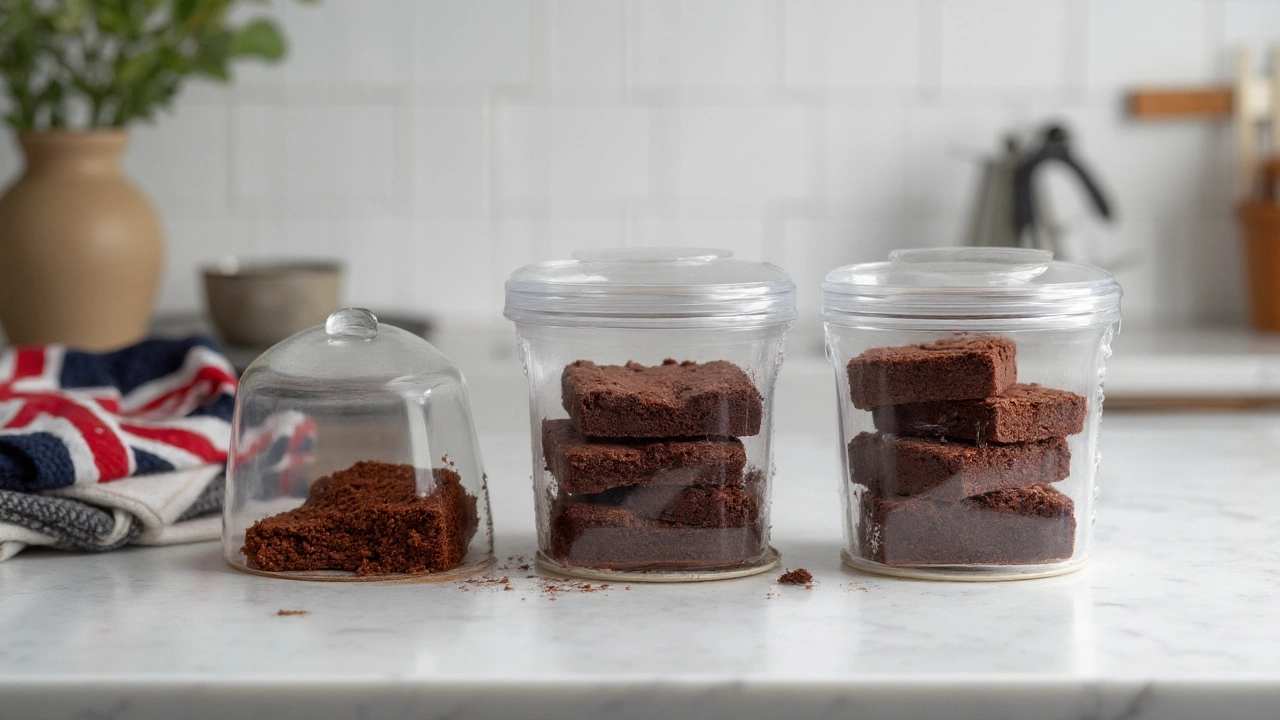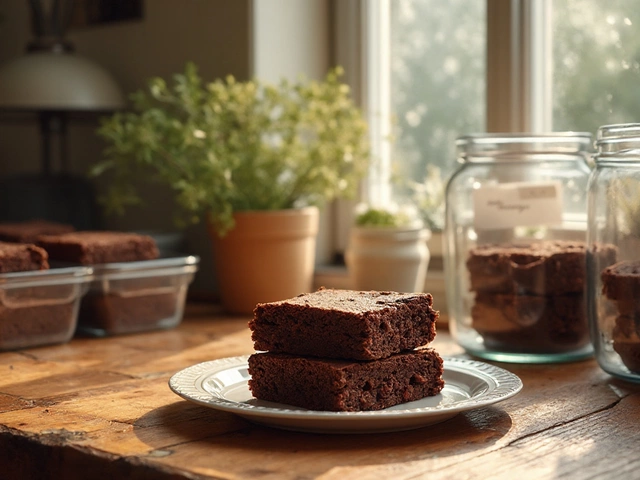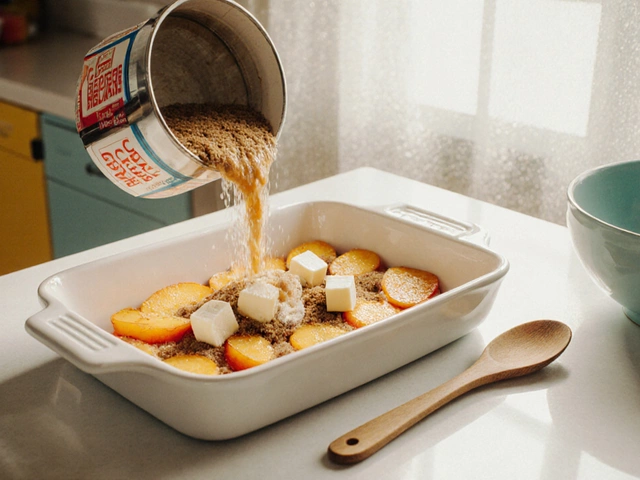
If you’ve ever baked a batch of perfect brownies and found them hard as bricks after a day or two, you know the heartbreak is real. So, where’s the best spot to stash these chocolatey treasures for max freshness? Some folks toss them in the fridge, others leave them out, and a few even swear by the freezer. But those methods aren’t just about taste—they can make or break your whole brownie game. The truth is, storing brownies isn’t just about not letting them go stale; it’s about keeping that mind-blowing fudgy texture, gooey bits, and flavor that stays true for days (or maybe longer, if you can resist eating them that long!). I’m telling you, the difference a good storage method makes is wild—just ask anyone who’s ever had a brownie dry out overnight. Let’s talk about what really works and how science (and a sprinkle of chocolate wisdom) can keep your brownies at their very best.
The Science Behind Brownie Freshness: Air, Temperature, and Moisture
You know that feeling when you bite into a brownie and it’s dry on the edges but the middle is still soft? That usually happens when moisture is lost unevenly. Brownies are basically a delicate balance of fat (hello, butter or oil), sugar, and flour. Each ingredient reacts to air, temperature, and even humidity. So it’s way more than just throwing brownies into a box and hoping for the best.
Let’s start with air exposure. The main villain when it comes to stale brownies is oxygen. When exposed to the air, brownies lose moisture and the fats begin to break down—their goo factor disappears. That’s why leaving them uncovered on the counter is a big mistake. Wrapping them tightly slows this down, but not all wraps are created equal.
Temperature is the next big factor. If you leave brownies at room temp, they stay nice and chewy for about 3 to 5 days—if covered well. But the exact window depends how humid (or dry) your kitchen is. If you like them even softer, don’t cut them right away; brownies actually keep their moisture better as a whole slab. That’s because the sides act as a moisture “seal,” only exposing the smallest area possible to air.
Chilling brownies in the fridge can extend their life, but cold temps can also make the texture less tender and sometimes weirdly dense. Still, the fridge is a good move if you live somewhere super hot or humid. Just make sure you’re wrapping each piece tightly in plastic wrap or foil first, and then put them in an airtight container. This double-barrier method locks in the texture. Honestly, a study from Michigan State’s Food Science program in 2023 found brownies stored in airtight containers at room temperature kept over 85% of their original moisture after 72 hours, compared to only 63% when left uncovered. That’s a serious difference in chewiness!
Freezing is the wild card. If you want to keep brownies for weeks, the freezer is a winner. You’ll need to cool them completely first (no steam trapped!) and wrap them tightly. Then pop them into a freezer bag, squeeze all the air out, and seal. When you want a brownie, thaw at room temp, and if you like a bakery-warm feel, zap one in the microwave for 10 seconds. No freezer burn, no icy aftertaste—just pure chocolatey goodness.
Want numbers? Here’s a handy data table summarizing storage outcomes:
| Storage Method | Time Span | Texture Loss (%) | Moisture Retained (%) | Recommended for... |
|---|---|---|---|---|
| Uncovered, Room Temp | 1 day | High (~50%) | ~50 | Immediate snacking |
| Airtight Container, Room Temp | 3-5 days | Low (~15%) | ~85 | Daily treats |
| Wrapped + Fridge | Up to 10 days | Moderate (~25%) | ~75 | Hot/humid climates |
| Wrapped + Freezer | Up to 3 months | Minimal (~5%) | ~95 | Batch prepping |
So, if chewy is your thing, best brownie storage means an airtight container at room temperature, eaten within a week. For longer storage, go with the freezer. It may seem like overkill, but the proof is in the bite.

Practical Tips and Storage Hacks for Mouthwatering Brownies
Let’s be real for a second: even store-bought containers won’t save brownies if you cut corners with wrapping or container choice. That’s why a few practical hacks always come in handy—call them “insurance policies” for your chocolate sanity.
First up, container material matters more than you’d think. A plastic container with a tight seal traps moisture better than glass, which can sometimes let in sneaky air. Still, if you want to avoid that faint plastic aftertaste, glass containers with silicone lids are a sweet compromise. Go for a size that fits your brownies snugly; too much open space means more air floating around and drying things out.
Some bakers place a piece of parchment or wax paper between layers of brownies. This simple move keeps them from sticking and helps them keep their shape—especially important for gooey or frosted brownies. Speaking of frosting, keep brownies with icing separate from plain ones. Frosted brownies need to be wrapped even tighter, since the moisture from the icing can make everything soggy or cause it to melt onto other pieces.
If you’re in a climate where brownies go stale in a blink, add half a slice of white bread to the container. Bread loses moisture faster than brownies, so it sacrifices itself to keep them soft! It’s not a myth; it actually works, thanks to osmosis.
How you cut brownies also makes a difference. Try slicing only what you plan to eat and keeping the rest as a slab, like a cake. This hack reduces the area exposed to air. Also, don’t forget about labeling! If you’re storing batches in the freezer, slap a date on each package—trust me, you’ll thank yourself a month later when you uncover a surprise stash. And always cool brownies completely before wrapping or storing. Trapped heat spells disaster: condensation turns to steam, which then makes brownies sticky and weird.
Transporting brownies? Wrap them in parchment and then in foil to avoid sweating on a hot day. Want them warm with ice cream? Zap a refrigerated brownie for seven seconds. For frozen brownies, about 15 seconds does the trick. These little details make all the difference.
Here’s a recap list for quick go-to success:
- Always store fully cooled brownies.
- Use airtight containers sized to fit the batch.
- Layer with parchment if stacking.
- Add half a slice of bread for extra moisture retention.
- Label and date freezer batches.
- Microwave before eating for bakery-soft texture.
These habits may sound small, but over time, they can make or break your brownie stash’s life span (and snack quality!).

Common Storage Mistakes and How to Avoid Brownie Disasters
It’s wild how easily a batch of brownies can go from hero to zero. There are some classic mistakes people make—usually not on purpose, but the results can be tragic for a real brownie lover. First, the big one: stashing brownies still warm. The steam trapped inside the wrap or container creates a sticky mess and, sometimes, a subtle sour taste. Always cool on a wire rack so air circulates and moisture isn’t trapped against the bottom.
Double-wrapping seems like overkill, but it’s worth it, especially with intense flavors (think peppermint or espresso brownies). Failing to do this can make flavors “bleed” into each other, and trust me, lemon brownies with a hint of chili from last night’s leftovers won’t win hearts.
Another classic error is freezing brownies that still have a lot of air (or headspace) in the packaging. Ice crystals will form, and freezer burn sets in—bye-bye fudginess. Expelling as much air as possible is nonnegotiable. Vacuum-sealed bags are king, but if not, lay brownies flat, squeeze carefully, and seal tight.
Leaving brownies out “just for the night” uncovered can be an assumption that costs you. Even a few hours in dry air is enough to crust the edges and harden the texture. Place them in a closed container as soon as they’re cool.
Refrigerating brownies “just in case” is common, but the fridge only prolongs freshness if the brownies are tightly wrapped. Otherwise, the constant flow of cold air dries them out fast, sometimes overnight. And brownies stored with fresh fruit or cream-based frostings (think strawberry swirl versions) must always go in the fridge; those perishables can spoil at room temperature.
If you’ve ended up with slightly hard brownies, don’t toss them yet! Pop them into a microwave with a damp paper towel for 10 seconds. Or try re-baking the batch for 2-3 minutes at 250°F (120°C); it can help soften things up without fully drying them out—just keep a close eye on them.
And for the adventurous, if you freeze brownies with mix-ins like marshmallows or caramel, watch out: sometimes those elements don’t survive the thaw with their texture intact. It’s smarter to freeze plain brownies and add toppings later. If you’re sending brownies as care packages, vacuum sealing is your best bet—nothing keeps them fresher for cross-country journeys.
To wrap up this whole chocolatey storage saga, just remember: fresh brownies deserve a little protection, a snug home, and a bit of attention. Store them wisely and you’ll never have to mourn a dried-out batch again.








Write a comment